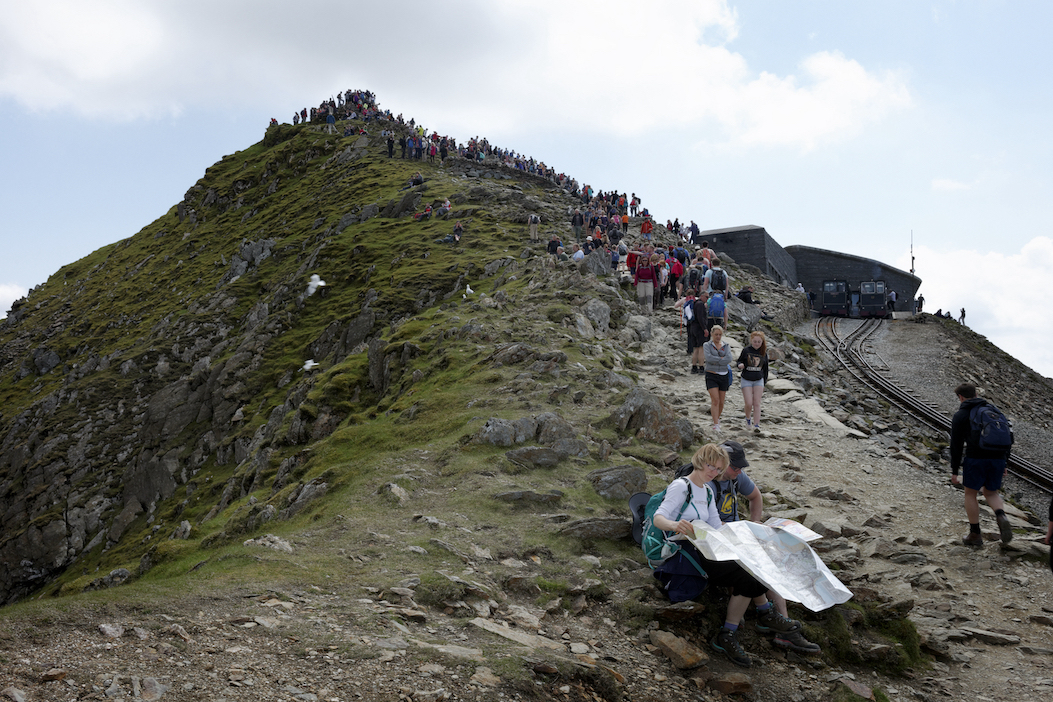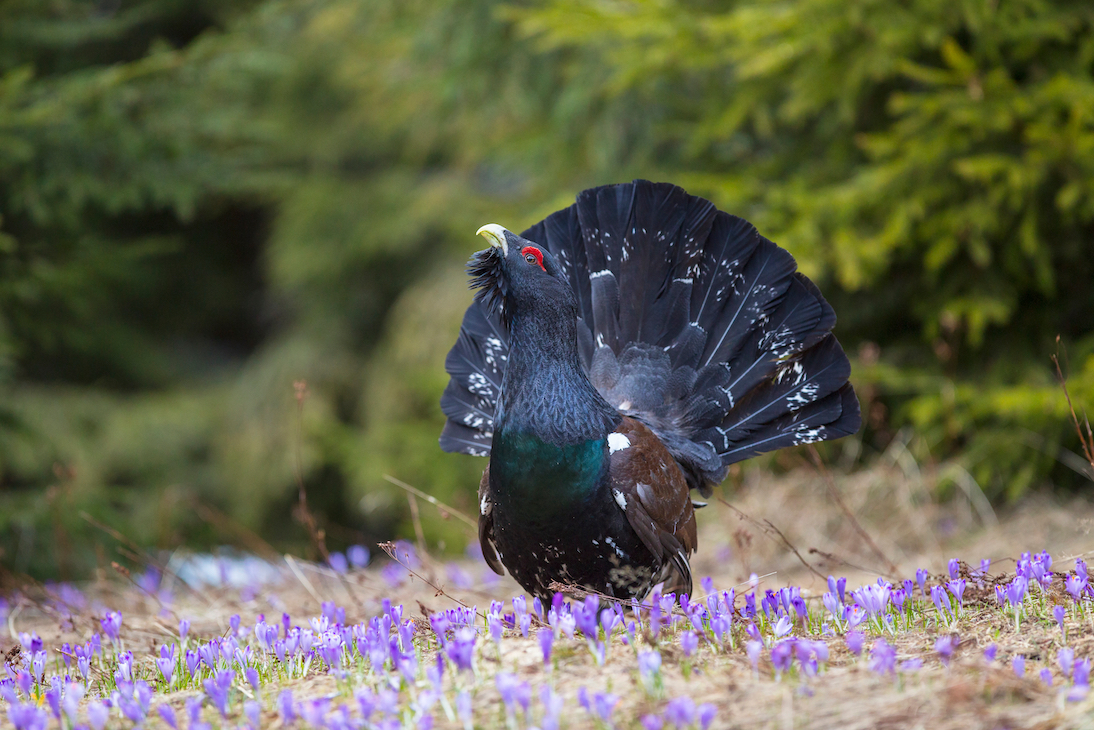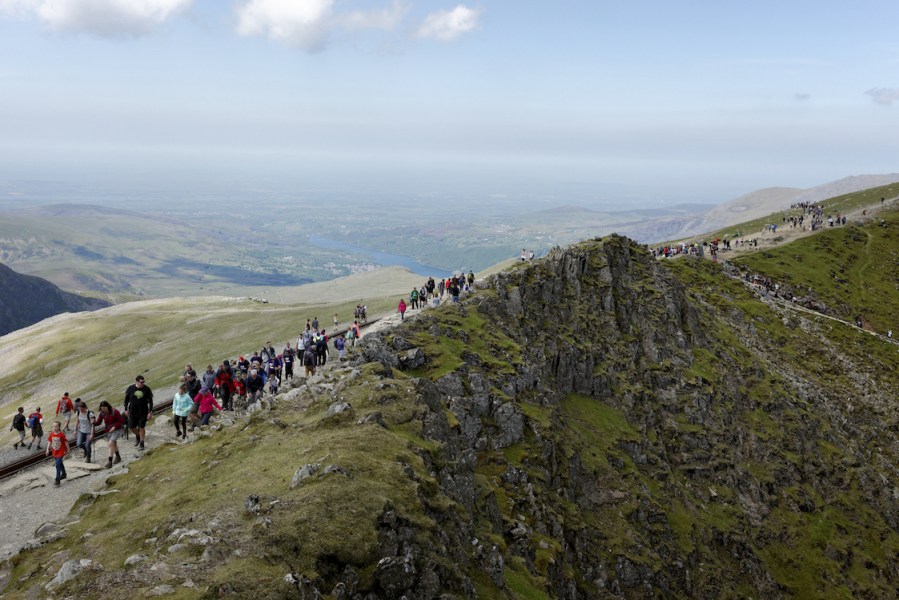More access to our landscapes could be seen as a threat to nature – but with the right thinking, it could actually be a great benefit, says guidebook writer Paul Besley.
Main image: crowds make their way to the summit of Snowdon. Photo: Shutterstock
The recent good weather over Easter brought lines of cars heading for the hotspots of the Peak District from early morning, and by midday the hills were full of walkers. As my Border Collie (Scout) and I walked onto Derwent Edge I could sense the release people felt, the gritstone and peat easing out people’s anxieties.
As the pandemic slowly fades, walking remains. The simple act of putting one foot in front of the other is more popular than ever. It’s hard to argue with the improved physical and mental well-being that results, yet more boots on the ground places further pressure on our landscapes. Over nearly 50 years of walking, I have seen visitor numbers explode and the paths around more popular areas paved with stone, going some way to remedy erosion but at the same time, changing the nature and experience of a place.
Increasingly, our media is awash with images of people queuing to gain a summit and snaking lines of walkers crossing the countryside. Geotagging photos and ‘top ten best…’ articles add to the honeypot effect in certain places, meaning more crowding and more erosion.
There’s much criticism of this behaviour, even some disdain and elitism from within the outdoors community itself, but just where should people – especially beginners – go?
All things to all people
As Easter passed, the government abruptly ended the ‘Agnew Review’, set up to consider whether responsible public access to private land could be increased from the current, paltry 8% of England and Wales.
Adding insult to injury, the pronouncement that we already had enough paths to walk on came just a few days before the 90th anniversary of the Kinder Trespass, a revolutionary act that highlighted what limited freedom we had. Now – partly due to the effect of the pandemic, and partly down to the very dynamic Right to Roam campaign, which recently led the excellent Kinder in Colour event – there’s a growing thirst for much, much more than a mere 8%.
“We belong here.” Oh to be told that, to say the words out loud amongst hundreds of kin, and dare to believe it – against so much evidence to the contrary – that’s what today was about 💓 #KinderInColour #KinderTrespass @Right_2Roam pic.twitter.com/qYIv2vx1HX
— Anneka Deva (@annekadeva) April 24, 2022
Yet we also want more nature in our landscapes, and it’s a matter of urgency. In January this year, the government published its response to the Landscape Review of 2018, which pledged to protect 30% of the landscape for wildlife and nature. We’re in a climate and nature emergency. British bird and insect numbers are in freefall, so surely this is welcome. Whether that pledge is actioned or not remains to be seen, but if a third of outdoor spaces really are given over to wildlife, what might it mean for us?
The same report also identified that our landscape “does not have sufficient resources currently in place…to attract new and larger audiences.” That’s bad news for people just taking up walking, and those from black, Asian and minority ethnic communities, who make up 13% of the population yet are significantly underrepresented in our outdoor spaces and institutions.
It seems the land must be all things to all people. How can we possibly square this circle?
Restrictions?
In the United States, some national parks and ‘wilderness areas’ restrict access via a permit system, allowing only a limited number of people to walk the trails each day in order to limit human impact. Should we do the same here? This way of managing footfall may feel alien to many of us in Britain, but before we kneejerk, let’s consider examples of access restriction – quite apart from that of private property – that are more familiar and closer to home.

Queues leading to the summit of Snowdon over the May Bank Holiday in 2016. Photo: Shutterstock
The British Mountaineering Council access team run the excellent Regional Access Database system, which warns users of local, temporary access issues; for example, nesting birds on climbing crags. It’s all on a smartphone app, making it easy to check your chosen venue before setting out. Working in partnership with other local stakeholders, could walking groups seek a voluntary restriction on eroded paths? A large number of mountain bike trail organisations already do. They ask riders to choose another route when conditions are poor. They promote trail closures for repair work through their website and social media. And, crucially, they thank riders for respecting closures. The biking community is proactively caring for the resources it values. Should the walking community follow their example?
Spread the load
Of course, the most immediate action we can take personally is to choose a quieter route. Encouraging visitors off the beaten track is something that some of us who write, photograph and guide in the outdoors already do, and could do more of.
But on a small island, where 92% of England and Wales’ landmass is inaccessible, this approach soon meets it’s (un)natural limit – the law. That’s why it’s essential we support the campaign by the Ramblers and Right to Roam for an expansion of access, along with educating people how to follow the updated Countryside Code.

Endangered capercaillie. Photo: Shutterstock
It’s counterintuitive to say that more access would mean less erosion, but I believe it’s the concentration of humans in tiny areas that’s the problem, not the people themselves. We urgently need to spread the load. Every one of us should join those organisations, sign up for news, join a protest, write to our MP’s. Groups should run workshops, speak to individuals on the hill and promote the campaign through social media and websites.
Even after all this, I believe there should still be serious conversations to be had about areas of total exclusion, to allow our increasingly beleaguered wildlife – be they capercaillie in the Cairngorms or ring ouzels on Stanage – breathing space to recover. But as is stands, it’s difficult to make a viable case for more restrictions to a general public that’s already denied the freedom to explore the vast majority of its own land responsibly.







